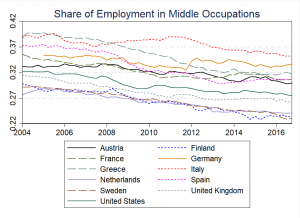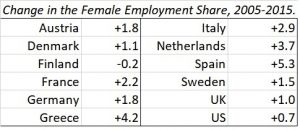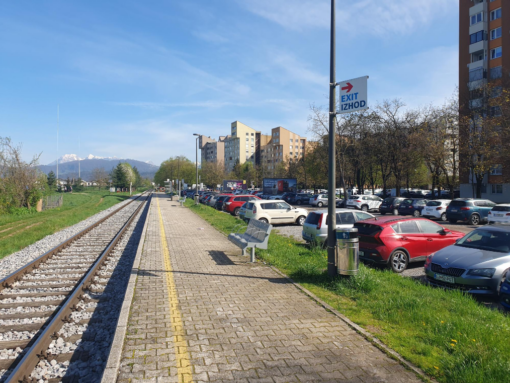Iacopo Morchio is assistant professor at the Department of Economics. In this blog post he describes his current research on recent trends in European labour markets, and
how they relate to this term’s question: “How will we work tomorrow?“.
I have always been particularly interested in how economic systems, and the incentives they create, shape our lives. Working at the intersection of labour economics and macroeconomics allows me to look at data from the real world through the lens of theories of individual behaviour, and to study the consequences of economic choices on overall welfare.
How women, education and technology are changing European labour markets
The question of how work is changing over time and how it will change in the future is one of the most interesting and crucial questions there is. To me there are at least three fundamental aspects to understanding how work is changing, which can be summarised in the following three questions:

- Who is working? That is, which people decide (or manage) to work, and which do not?
- What kind of work do they do? In which occupations and industries is work concentrated?
- What are the conditions under which they work? In particular, how many hours do they work and for which wage?
We are exploring these questions in a joint project with Stefania Albanesi (University of Pittsburgh) and Monika Merz (University of Vienna). We use data from harmonised labour force surveys and data on wages to study long-run trends, such as changes in production technology and the increase in the number of workers with higher education degrees, and their implications for European labour markets during the last twenty years.
Understanding what forces have shaped labour market outcomes in Europe during this period, which includes the 2008-2009 recession, matters for researchers and policy-makers alike. The answers to the questions mentioned above are essential for predicting what kind of jobs are likely to disappear and which new work opportunities will most likely arise in the near future, thereby highlighting challenges for policy-makers.
The two main forces: women and skills
We find two fundamental forces at work: the first is the rise of female labour force participation, which is still well underway in Europe, while it has essentially stalled in the United States. Women now account for a substantially larger fraction of employment and hours worked than 15 years ago. The second is an increase in the demand for college-educated workers compared to others, which is most likely the result of technological changes in productive processes that now favour higher skills more than before. For example, modern economies have a much higher demand for programmers and IT experts than economies 50 years ago.

This second phenomenon has been accompanied in all countries by what has become known as “job polarisation” (Autor, Katz and Kearney 2006; Autor and Dorn 2013). In loose terms, this means that if we rank jobs by their economic status, there are fewer jobs in the middle of the ranking than there were in the past, while there are now far more jobs at the top and bottom of the ladder. This has happened because the industry in developed countries plays a less central role. In addition, many of these middle-ranked jobs involved a set of possibly complex, but routine repetitive tasks, which companies have found ways to substitute with specialised machinery, hardware or software. Polarisation has occurred fastest in Greece and Spain, particularly during the recession, but it has happened in all other countries we are studying as well, with the exception of Italy.
Basic economic arguments would suggest that the increase in female participation relative to male participation and the fact that more people now pursue higher education than before would lower the wages of women and of college-educated workers, because there are now more women and college-educated workers in the labour market. Instead, we find that the wages of these groups have at least not decreased relative to the wages of other workers. This suggests that the increased demand for highly skilled workers and female workers has more than compensated for the increase in supply. This leads us to conclude that the changes in production technology have increased companies’ demands for higher-educated workers to complement these technologies and, therefore, have been one of the key driving forces of recent trends.

Finally, we find that employment in most European countries has recovered after the last recession, which was similar to previous recessions, and that this was not related to the degree of job polarisation in those countries. This is a clear contrast to the situation in the United States, where employment now tends to recover much slower than in the past, resulting in so-called “jobless recoveries”. This finding is important, because other studies (Jaimovich and Siu, forthcoming) have suggested a link between job polarisation and “jobless recoveries” in the United States. We do not find evidence for such a link in European-level data.
What next for European labour markets?
Answering the question of “how will we work tomorrow” requires some guesswork and a leap of faith with respect to what is going to happen in the future. Therefore, what follows is my educated guess on where labour markets are headed, based on the extrapolation of past and current trends.
If current trends continue, women and higher-educated individuals will in the future constitute an increasing share of the workforce. It is likely that the wage gap between college-educated workers and other workers will not decrease. Regarding the kind of jobs that workers will do, it is likely that occupations at the top and bottom of the skills distribution will become more important in the labour market, because both categories are hard to automatise. The OECD Employment Outlook 2019, for instance, suggests that “[…] 14% of existing jobs could disappear as a result of automation in the next 15-20 years, and another 32% are likely to change radically as individual tasks are automated“. In particular, some low-skilled occupations are likely to become less prevalent in the next 20 years: For instance, many companies are trying to develop automatic driving systems. If successful, these systems might replace truck drivers and cabs almost completely.
 You are interested in topics related to work and the future of labour markets?
You are interested in topics related to work and the future of labour markets?
👉Follow this link for more information, blogposts and research on this term’s question “How will we work tomorrow?” and join us on Monday, 27th May for the concluding panel discussion with experts and scientists at the University of Vienna (in German).
References
Autor David H., and Dorn David. “The growth of low-skill service jobs and the polarization of the US labor market.” American Economic Review 103.5 (2013): 1553-97.
Autor David H., Katz Lawrence F., and Kearney Melissa S. “The polarization of the US labor market.” American economic review 96.2 (2006): 189-194.
Jaimovich Nir and Siu Henry. “The Trend is the Cycle: Job Polarization and Jobless Recoveries”, Review of Economics and Statistics (forthcoming).
OECD (2019), OECD Employment Outlook 2019: The Future of Work, OECD Publishing, Paris, https://doi.org/10.1787/9ee00155-en.



